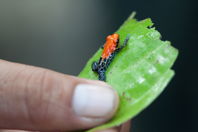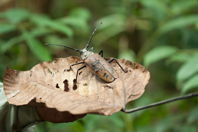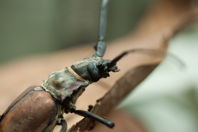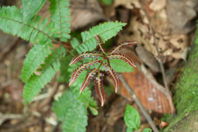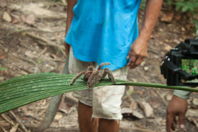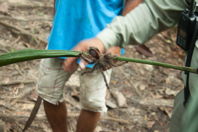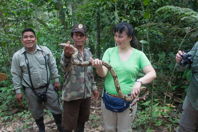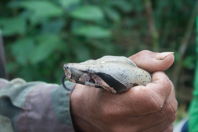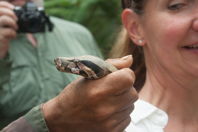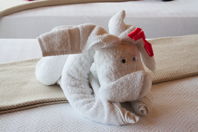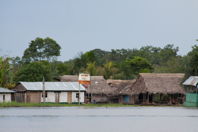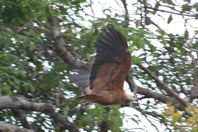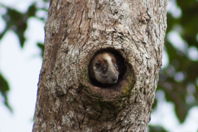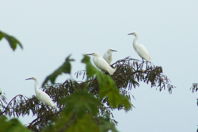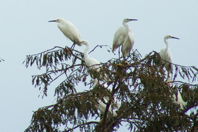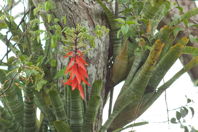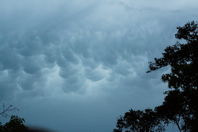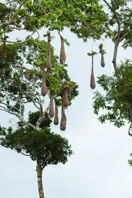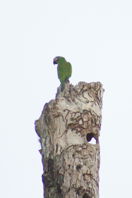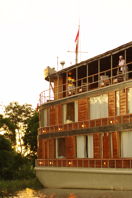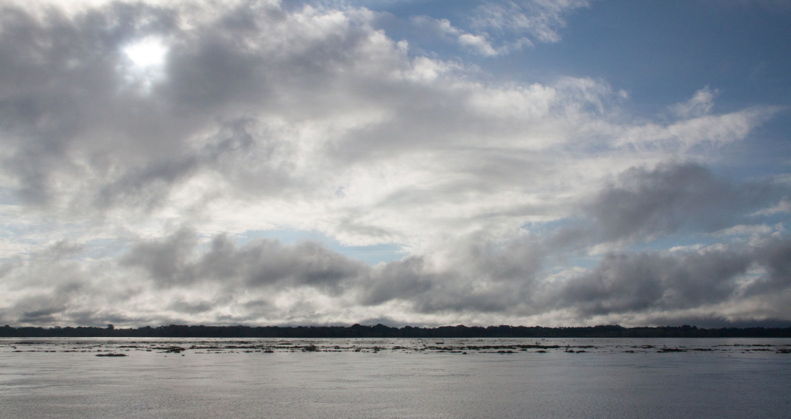
|
| Amazon sky, 7:10 a.m. |

|
| Panorama of the river at 11:25 a.m., from the top deck of Delfin II (bigger image). |
Thursday, April 16, third day in Perú
On the Amazon and into the jungle
After breakfast, we piled onto skiffs for a short ride to a landing from which we took a nice jungle walk. A forest ranger spotted all sorts of things we wouldn’t have noticed on our own: a poison-dart frog, a huge gigantic tremendous beetle, and a nice friendly tarantula. I had my fine macro lens plugged into the camera at the time, and when I managed to get things in focus, details really stood out. Like the individual facets in the eye of the beetle—you’ll need to look at the big version of the picture to see this.
And we got up close to a red-tailed boa—this is a common species often kept as pet. In the top picture to the right, Catherine is clearly of two minds about holding the beast.
I took no more pictures till our return to the Delfin II. My journal says, «Then a small market catering to the tourists, where I bought a little rattle in the form of an armadillo, for S/10 (about $3.50). Money well spent. There we caught the skiff for a very short (2-min.) trip to the Delfin II. Strip off our sweat-soaked clothes, change, then a wait for the other group to return, and then a short talk to acquaint us with the two rivers we’d be traveling in, the Marañón and the Ucayali, whose confluence forms the Amazon.»
In Costa Rica, we learned to watch for towel origami, so we were charmed but not surprised to see some when we returned for our showers. Mark and I had no idea what this was supposed to represent, but at lunch, we showed a picture to Melissa and Steve, and Melissa decided, with our agreement, that this must be a donkey.
Lunch itself was notable, with a large and perfectly cooked piece of beef, preceded by “Oscar carpaccio”. Any home-aquarium fanatic knows of a fish called Oscar, and if you follow the link to the always-reliable Wikipedia, you’ll see that it gets big enough in the wild to be sold in local markets for food, so I reckon that we really were eating wild samples of the aquarium fish.
My journal says, «After lunch, I slept for a while, but got up in time for another skiff trip, to an oxbow lake where we saw gray rivier dolphins (several) and, from our skiff, Steve, Melissa, and I had a swim. In the Amazon River! I took only a few dozen strokes before climbing out: the water was calm and warm, but I did not feel at ease, and stayed near the boat. I think that our naturalist guide Chino was relieved when I climbed back up out of the water.»
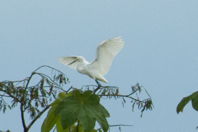
Great egret spreads her wings
(bigger image).
Back to the Delfin, for a quick change to dry clothes and to pick up my camera, to which I fitted the telephoto lens. It’s not a great one, but goes to 300mm, which can give a good close-up view; unfortunately, at that focal length, the images are rarely clear. I took the camera with me on another skiff expedition, in search of wildlife—maybe monkeys?—and we saw no monkeys, but plenty of birds. I snapped pictures of the high-water-level village that you see to the left at around 4:30 p.m., and the black-collared hawk maybe a quarter-hour later.
| Eighteen-second clip taken at 4:35, on the river |
Around this time, Chino pointed out a big bird, and Mark correctly identified it as a Hoatzin, probably the most unusual bird in the world. The youngsters have claws on their wings, for instance, used for climbing up into the trees after they fall into the water. It’s the only completely herbivorous bird, too, with a digestive system that uses bacterial processes for breaking the cellulose down, and the crop is so large that there’s not much room for breast muscles. It’s a weak flyer, as a result. Anyhow, I had told Mark that one of my big objectives was to see some of these weird birds, so he was on the alert. He got a number of fabulous pictures of them too, as you can see on his pages, especially the page for 17 April. For my part, I got zero pictures of my target. Too slow on the uptake, with a camera that was not as maneuverable as Mark’s.
As I suggest above, I have been rather disappointed in the clarity of my pictures, more exactly in the lack of clarity. But the pictures of the Great Egret to the left redeem all: they are crops from a single shot that’s wonderfully clear. The bird is common almost everywhere you look, not only here in Perú but in the southern U.S. as well. It’s Ardea alba, in the same genus as the Great Blue Heron that we see everywhere in New England, and I guess in most of the rest of the U.S. too.
As we went along the river, there were all sorts of interesting things to see. Like the showy bromeliad flower to the right, and the hanging nests of either the yellow-rumped cacique or a similarly-nesting bird shown beneath that. In the upper right of that block, however, you see a not-very-clear representative of a fairly unusual kind of cloud, the mammatus, so named because they look like udders. In the middle of the bottom row there is a green parrot of some kind: Mark identifies it as a red-bellied macaw; at the right is a shot of our Delfin II taken as we approached it in the evening, at around 5:50.
In the block of six below, there are three of the river-side taken eastward so that everything was illuminated by the setting sun. the first picture has just the tab end of a rainbow in the middle. Those pictures were taken from the skiff, slightly before the picture of the bow-end of the Delfin to the right. After we got aboard, I took the pictures of the sunset from the top deck. These are only a selection from the several that I took at that time.
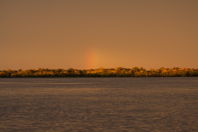
|
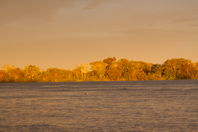
|
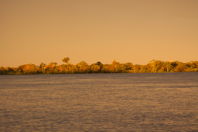
|
| Big image, small. | Big image, small. | Big image, small. |
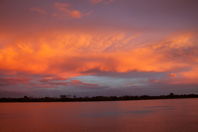
|
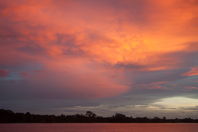
|
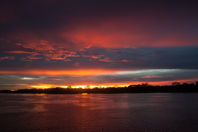
|
| Big image, small. | Big image, small. | Big image, small. |
| 22-second clip taken towards sunset, 5:35. |
It was a very full day, with adventures and photo-taking in abundance. And it was our first full day on the Delfin II, so it’s appropriate to close with a picture of the whole crew, whose excellent service was making the entire excursion an extremely great pleasure.
My journal entry for the day does not mention the dinner menu, since it clearly was written before the meal. But Mark has some comment on the dinner and you can read about that at the bottom of his page for the second half of this day.
From there, we retired, to prepare mind and body for the next day.
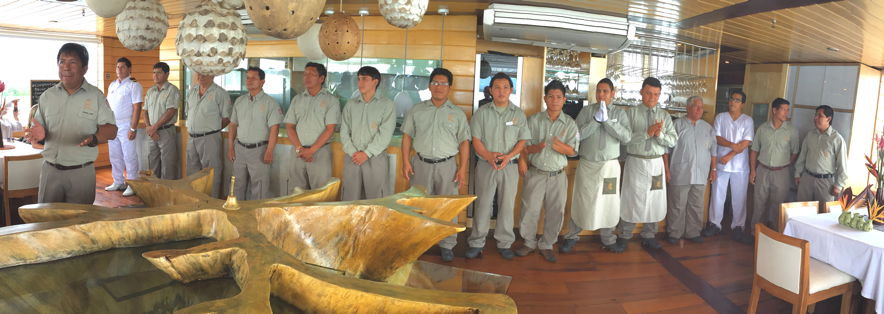
|
